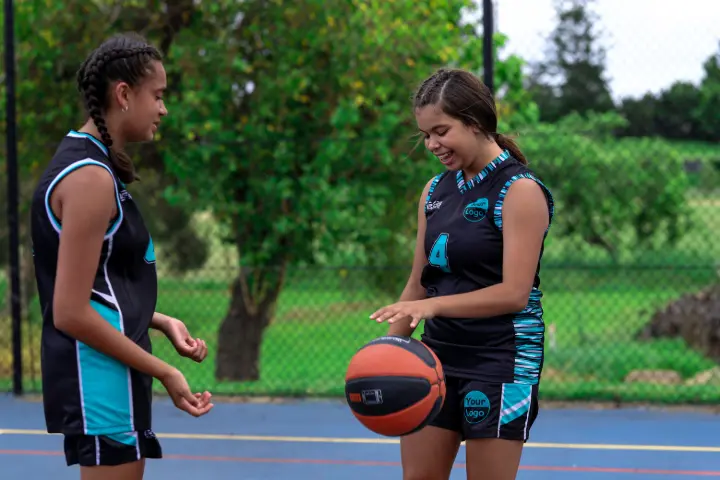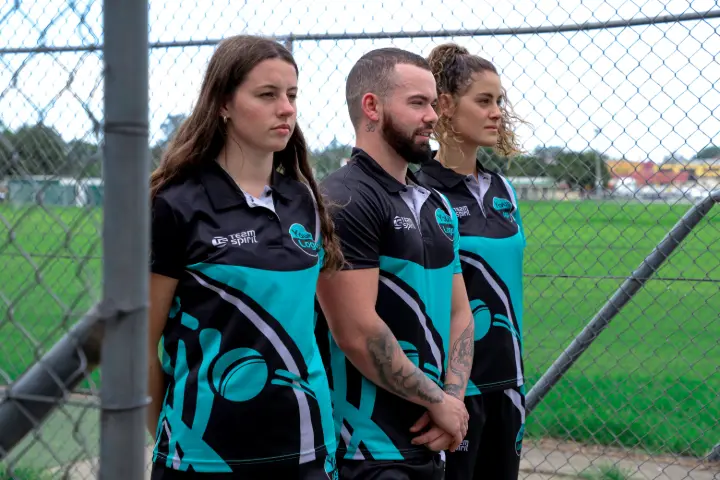When choosing the right clothing for school sport, team training, or everyday fitness, understanding the difference between sportswear and activewear is key. While these terms are often used interchangeably, they serve very different purposes, from fabric and fit to function and durability.
In this guide, we’ll break down what sets activewear apart from sportswear, where each type shines, and how to choose the best option for your school, club, or organisation. Whether you're after stylish, comfortable gear or performance-driven uniforms, knowing the difference helps you get the most from every wear.
What is Sportswear?

Sportswear, on the other hand, is purpose-built for athletic performance and competition. It’s designed for durability, support, and functionality during structured sports and physical education.
You’ll find sportswear in school PE programs, on club footy fields, and in professional training environments. Its construction prioritises freedom of movement, temperature regulation, and long-term wear resistance.
Common sportswear items include:
-
Team jerseys and guernseys
- Netball dresses and shorts
- School PE kits
-
Track pants and sports polos
Where activewear is flexible and lifestyle-focused, sportswear is about performance, durability, and customisation, especially with the inclusion of logos, house colours, or sponsor branding.
Benefits of Sportswear
1. Built for Performance
Sportswear is made to support athletic output. From sublimated jerseys to moisture-wicking track pants, every feature is engineered to enhance performance, whether that’s in a competitive footy match, netball tournament, or inter-school athletics day.
2. Durable for Repeated Use
Custom team uniforms and PE kits take a beating and sportswear is built to handle it. Reinforced stitching, high-performance polyester, and fade-resistant prints ensure that items stay sharp and intact even after repeated washing, wear, and use on the field.
3. Promotes Team Identity
Sportswear plays a major role in team pride. Through custom colours, logos, and player names, schools and clubs can create a unified look that boosts confidence and cohesion. Sublimated designs and embroidery help represent school spirit, especially at competitive events and carnivals.
What is Activewear?
Activewear refers to clothing designed to be worn both during exercise and as part of casual, everyday outfits. It's built for flexibility, comfort, and ease of movement, making it ideal for light workouts, gym sessions, or even lounging at home.
In recent years, activewear has also become a fashion statement, blending functionality with style. The rise of athleisure means these garments are not just for the gym but are also worn in classrooms, cafes, and everyday settings.
Common activewear items include:
-
Leggings and yoga pants
-
Fitted hoodies and sweatshirts
-
Stretchy tanks and crop tops
- Joggers and soft-touch tees
The emphasis is on versatility. Activewear is built to move with the body while maintaining a sleek appearance. It’s typically made with breathable, moisture-wicking fabrics and is often form-fitting for ease and comfort.
Benefits of Activewear
1. Versatility for Multiple Activities
Activewear is designed for flexibility. It works just as well for a yoga session as it does for casual wear around campus. The ability to go from gym to classroom or from training to school pickup makes activewear especially useful for staff and students who need functional gear with everyday appeal.
2. All-Day Comfort
Built with soft, stretchable fabrics like cotton-spandex blends, activewear provides superior comfort for low to moderate intensity movement. Loose fits, flat seams, and breathable materials make it ideal for general fitness, wellness programs, or less structured school activities.
3. Stylish and On-Trend
Thanks to the rise of athleisure, activewear offers a sleek, modern look. Whether it’s leggings, fitted hoodies, or minimalist tees, this type of gear fits well into school environments focused on comfort without compromising appearance, making it a popular choice for casual events or staff attire.
Sportswear And Activewear: Fabric and Material Considerations

Activewear Fabrics
Activewear is usually made from lightweight blends of cotton, spandex (elastane), and polyester. These materials offer the stretch and breathability needed for gym workouts, stretching sessions, and daily wear.
Key fabric features:
-
Moisture-wicking: Helps move sweat away from the skin
- Stretchability: Great for dynamic movement (e.g., yoga, Pilates)
- Soft touch: Comfortable enough for all-day wear
This makes activewear a good option for students and staff participating in casual wellness programs, or for off-field apparel.
Sportswear Fabrics
Sportswear is engineered for rugged use in competitive and high-impact environments. It relies on high-performance synthetics like polyester, nylon, and spandex blends, often with mesh panels for ventilation.
Key fabric features:
- Durability: Withstands frequent wear and washing
-
Compression: Offers muscle support and reduces fatigue
-
Temperature regulation: Helps keep the body cool or insulated depending on the season
These fabrics are ideal for custom sports kits, where sublimated prints, embroidered logos, and tough seams need to last through training and game day.
Impact on Performance and Comfort
Choosing the right fabric matters, not just for comfort but also for athletic performance.
-
Activewear fabrics allow for comfort and flexibility during low to moderate intensity activities. They’re breathable and soft, but may not stand up to rigorous team training or contact sports.
- Sportswear fabrics, built for intensity, help regulate heat, support muscles, and maintain shape over time, critical for schools, clubs, and competitive teams.
By understanding these differences, schools and clubs can make more informed decisions when selecting gear for students, staff, and athletes. Whether you're dressing for the gym or gearing up for game day, the right material makes all the difference.
Design and Functional Differences of Sportswear And Activewear

Activewear Design Elements
- Fashion-Forward Aesthetics: Emphasis on trendy designs suitable for both workouts and casual outings.
- Versatility for Gym-to-Street Wear: Designed to transition seamlessly from exercise sessions to everyday activities.
- Comfortable Fits:Often features looser fits for enhanced comfort during various activities.
Sportswear Design Elements
-
Team Branding and Customisation: Incorporates school or team logos, colours, and mascots to foster identity and unity.
- Ergonomic Designs for Specific Sports: Tailored to meet the demands of particular sports, ensuring optimal performance.
-
Reinforced Construction: Built with durable materials and reinforced stitching to withstand rigorous activities.
Customisation and Branding
-
Importance of Logos and Colours: Utilising school or team colours and logos to promote a sense of belonging and pride.
- Personalisation Options: Offering customisation such as player names or numbers to enhance individuality within a team setting.
When to Wear Sportswear vs Activewear: Use Cases for Australian Schools & Teams
Activewear Applications
-
Casual School Sports Days: Suitable for non-competitive events where comfort and flexibility are key.
- General Fitness and Wellness Programs: Ideal for activities like yoga, pilates, or general fitness classes.
- Staff and Student Leisure Activities: Appropriate for casual wear during school excursions or informal gatherings.
Sportswear Applications
-
Competitive School Sports Teams: Essential for official matches and tournaments, providing team cohesion and performance support.
- Inter-School Tournaments and Events: Designed to meet the standards and requirements of competitive inter-school sports events.
- Physical Education Uniforms: Standardised attire for regular PE classes, ensuring durability and functionality.
Choosing the Right Apparel
-
Activity Type Consideration: Selecting attire based on the intensity and nature of the activity, activewear for low-impact, sportswear for high-impact.
- Climate and Environment: Considering Australia's diverse climates to choose appropriate materials and designs.
-
Budget and Longevity: Balancing cost with durability to ensure long-term value, especially for school budgets.
Activewear vs Sportswear: Which One Fits Your Needs Best?
When it comes to outfitting your school, club, or sports team, understanding the difference between activewear and sportswear can help you make more informed, cost-effective decisions. Activewear offers comfort, flexibility, and everyday appeal, perfect for casual programs and staff wear. Sportswear, on the other hand, delivers durability, performance, and team identity for competitive environments and PE classes.
Each has its place, and the best choice depends on your activity type, setting, and long-term needs.
Looking for high-quality, customisable uniforms for your school or club? Team Spirit Sports offers tailored solutions in both sportswear and activewear, designed to perform, last, and look the part. Contact us today to get started.